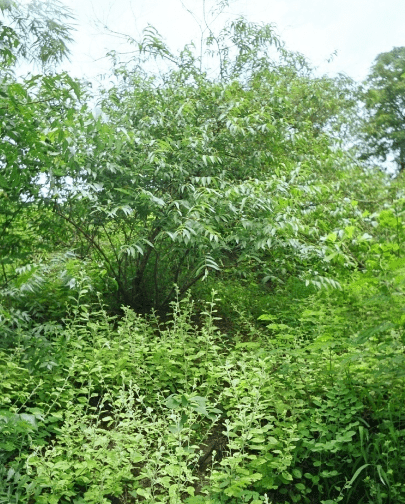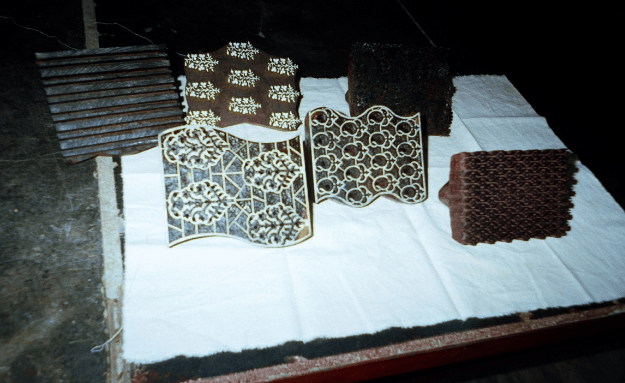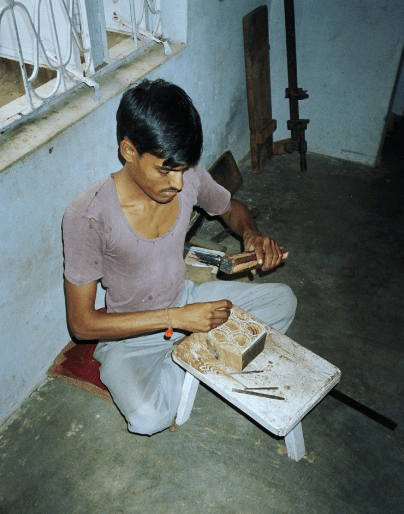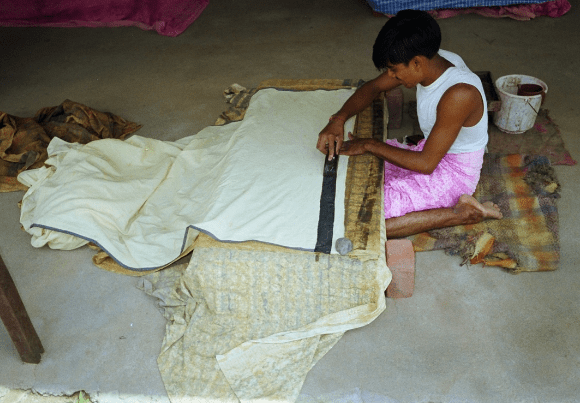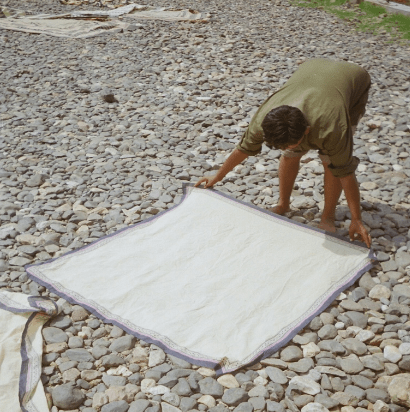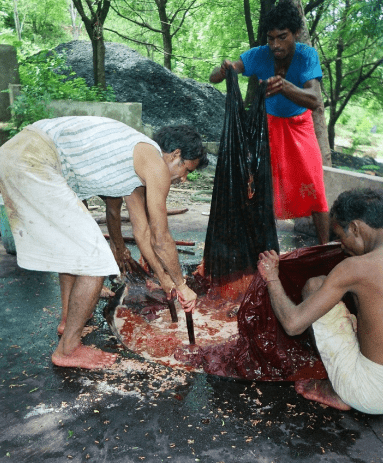Block printing is an ancient art that has been practiced in India for thousands of years. The earliest documented evidence of this craft are from the times of Alexander the Great in 327 B.C., when he mentions ‘beautiful printed cottons’ in India. In fact, historical data suggests that even as far back as the days of the Indus Valley Civilization block printing was in evidence in India: Archaeological evidence from Mohenjo-Daroe establishes that the complex technology of mordant dyeing had been known in the subcontinent from at least the second millennium B.C. The use of printing blocks in India may go as far back as 3000 B.C., and some historians are of the view that India may have been the original home of textile printing.
Bagh: A Geographical Introduction
Bagh is a village in Dhar district of Madhya Pradesh. It is around 150 km from Indore, the commercial capital of the state. Bagh gets its name from the ancient Bagheshwari Devi temple situated here, and is famous both for the ancient Bagh Caves, which are said to be more than half a million years old,3 as well as for Bagh printing.
This area is hilly terrain with thick forest cover and a considerable tribal population, mostly Bhils and Bhillalas. Other communities residing here are Other Backward Castes [OBCs] like Kurmis and Sirvi, and some Muslims, who are traditionally weavers.
Bagh Printing
Bagh printing in its current form started in 1962 when a group of Muslim Khatri weavers migrated from the nearby Manavar to Bagh. They were originally from Sindh [now in Pakistan], and had since migrated to Marwad in Rajasthan and then to Manavar. With them they brought the block printing technique, which is now the unique Bagh printing style.
Regions of Bagh Printing in India
Bagh printing is done exclusively in Bagh village in Dhar. However, other areas in India famous for block printing are:
•Rajasthan: Jaipur, Sanganer, Bagroo, Apli and Barmer
•Gujarat: Mandvi, Dhamardhka, Mundra, Anjar, Jamnagar, Surendranagar, Jaitpur, Ahmedabad, Baroda and Deesa
•Andhra Pradesh: Mausilipatnam
•Tamil Nadu: Tanjore
•Delhi
•Uttar Pradesh
Producer Communities
Bagh printing is controlled by the five to six Muslim Khatri families of Bagh village who own the manufacturing units here. The artisans working in these units belong to various communities like Rajput, Bhil, Bhillala and Teli. The Khatri families of the area have trained these artisans. Some Scheduled Caste and OBCs are also working in these factories. Thus, there is no suggestion of any linkage between the trade and the caste of workers, apart from the fact that the unit owners are invariably from the Muslim Khatri community.
Raw materials
For Bagh printing readymade cloth [of cotton, silk, etc., is purchased from dealers from various places, includingDelhi, Indore, Maheshwar and Chanderi.
Cotton
cloth is readily available in the nearby Indore market. The cotton normally used is from Century Mills for bed covers, table cloths, etc.
Silk-by-cotton
Silk cloth procured for the printing of the silk-by-cotton fabric is purchased from Maheshwar and Chanderi in Madhya Prades.
Silk
Silk cloth like georgette, crepe and chiffon are procured from Indore and Mumbai. Tussar silk is procured from Raigarh Chattisgarh and Bhopal
Jute
Dhaka jute is purchased from Delhi.
Tools Used
Various tools that are used in Bagh printing are as follows:
Vegetable Dyes
In Bagh printing, only vegetable dyes are used, the main colors being black and red. For black color, a mixture of harada and iron ore is used. For red, a mixture of alum and dhavda flower is used. These dyes are extracted and prepared locally.
Wooden Blocks
Wooden blocks are the main tools used in Bagh printing. These blocks are made of teakwood slabs purchased from the local markets. These wood blocks of various traditional and modern designs form the backbone of the craft.
Printing Tables
These are raised wooden blocks, around 5 ft in length and 3 ft in breadth. They are raised from the ground using bricks and wooden blocks to a height of about 9 inches. Covered with plain cloth for protection, these tables are used by the artisans for printing.
The Process of Bagh Printing
The process of Bagh printingis as follows.
Making Wooden Blocks
This process has the following steps:
•Preparing designs: The master weaver prepares designs on graph paper. This is normally a geometrical pattern or a natural design with flowers or leaves.
•Selecting the wood for blocks: Teakwood pieces without defects like warping, knots or irregular granules are selected for the preparation of wooden blocks.
•Preparing the block: The teak blocks are smoothened using carpenters’ tools. Following this, a white primer is put on the surface to make it smooth and clear. Then the craftsman draws the design on it from the graph paper.
•Engraving designs on the blocks: The craftsman engraves the delicate designs on the block using sharp carpentry tools. After first finishing, he checks the design by taking a print on a paper. After this, he provides fine-tuning to the block as required.
•Preserving the blocks: Once prepared, these blocks are immersed in oil for a few days so as to provide greater stability to them and to protect them against warping and insect attacks. This is also important as during the printing these blocks are constantly in touch with water-based dyes and are thus vulnerable to warping.
Preparation of Fabric
Raw material for the process [cotton, silk and combination clothes] is procured from various dealers in different cities [as mentioned earlier]. The Various stages involved are; The cloth is first washed in running water and left to dry in the sun before the printing. After drying, it is dipped in a solution of castor oil, centura and goat droppings [natural manure]. These substances react with each other to generate heat, which makes the fiber absorbent. The cloth is dipped repeatedly in this solution and is trampled by foot to produce froth. It is then left to dry on the ground. The logic behind this is that the heat from the ground helps the cloth dry quickly.
Raw material processing is carried out in tubs whose inner part is made of copper. This process also helps to reduce the levels of substances like kerosene and fibine. After the cloth dries, it is kept in a solution of tarohar and harada powder and left to dry in sun. It is necessary not to dry it in shade because the background color of the cloth becomes green rather than the desired yellowish. After completion of this process, the cloth is now ready for printing.
Printing
For printing, a paste is made by mixing the dye with dhavdagum. There are two types of pastes: one is red and the other is black. After preparing the paste, it is filtered and poured into a wooden tray. The dye is applied to the wooden blocks by pressing them on this tray.
Meanwhile, the yellowish cloth obtained from the earlier process is put across the table. A black margin is provided using plain stamps around the cloth.
The cloth now becomes a canvas for the craftsman, who skillfully makes the intricate designs by putting the blocks alternately in the tray containing the dye paste and on the cloth.
The color of the design is light at first, but it darkens immediately afterwards as the cloth soaks it in. The craftsman avoids overlapping in the corners of the cloth by putting an old cloth or paper where the printing has already been done. Different designs are put on the cloth by completing printing in rectangles, starting from the outer portion of the cloth and closing in as the cloth gets filed with designs.
Drying
Once the printing is finished, the cloth is left on pebbles to dry in the sun. This way it is dried from both sides, outer as well as inner. After this, it is again washed, this time in river water, and left to dry.
Dyeing
•Red: For making red dye, a solution of alum and the powder of tamarind seed is boiled and left to cool in a plastic vessel. This solution is then filtered through fine cloth. For deep color dye less viscous solution is used and for fine printing thick solution is used.
•Black: Blackdye is prepared by mixing alum and iron ore.
•Violet: For this indigo is used.
•Yellow: For this turmeric and harada are used.
After this comes the process of Dyeing. In order to provide the Bagh print cloth their characteristic contrast and finishing, the cloth passes through a process of dyeing once again. For this alizarin and dhavadi flowers are boiled together in big copper containers concealed in a cement structure under which a fire using wood, leaves, etc. is made. The printed cloth is put in these vessels and is left to boil there for five to six hours. The red printed portion, which has alum, takes its color by reacting with alizarin. At the same time, the dhavadi flower works like bleach on the unprinted portions, which have been dyed with harada to make it white after boiling.
Finishing
After this process, through which the cloth gets clear red, black and white colors, it is left on pebbles to dry. Packing follows the drying process, and the cloth is then ready to be marketed.
Use of the Product
Products of Bagh printing are used in a variety of ways, mainly as bedcovers, saris, suit pieces, curtains, scarves, handkerchiefs, etc.


